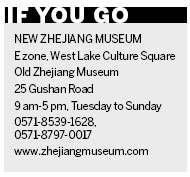Heritage
The swords of yue
Updated: 2011-06-26 07:39
By Zhang Kun (China Daily)
|
The Sword of the King of Yue (top), is now part of the collection of Yue weapons at the Zhejiang Provincial Museum. It is an excellent example of the foundry skills of the Yue blacksmiths. The sword handle (above right) is inlaid with turquoise, and scholars have deciphered the inscriptions on the handle (above left), which identifies the owner as the King of Yue, with his monogram - Zhuji Yushi. Provided to China Daily |

Almost 2,500 years ago, a dramatic tale of humiliation, defeat, subversion, revenge and victory was played out between the kingdoms of Yue and Wu. The main characters have faded largely into legend, but some very real relics serve as sharp reminders of that period in Chinese history. Zhang Kun reports.
The monument stands proudly in the front yard of the Zhejiang Provincial Museum, a sword piercing through its base of stone, a commemoration of the homecoming of one of the museum's most important exhibits - the Sword of the King of Yue, Zhuji Yushi (越王者旨於睗剑).
Zhuji Yushi ruled the Kingdom of Yue for only six years (464-459 BC), but he had many weapons made to his name, according to Liang Xiaoyan, a researcher with Zhejiang Provincial Museum. This sword was an example of the excellent foundry skills Yue blacksmiths were famous for. The craftsmen of the Kingdom of Yue, which occupied most of present day Zhejiang, had developed secret alloys of tin and copper that made the swords extremely sharp and sturdy. Some were so sharp that archeologists had cut themselves while uncovering these relics made two and a half millennia ago.
In October 1995, Professor Ma Chengyuan, an expert on ancient Chinese bronzes and the curator of the Shanghai Museum, received a faxed picture of a sword that he identified as the one belonging to Zhuji Yushi.
He was impressed enough to fly all the way to Hong Kong where it had been put up for sale. Once there, Ma experienced a moment of panic because he didn't have the HK$1 million ($128,400) that the seller wanted, but he could not let the sword go.
Pressure also came from a few overseas clients who had expressed strong interest and were willing to offer a higher price for the sword.
Ma called Professor Cao Jinyan, the incumbent associate curator of Zhejiang Museum then, suggesting that the museum buy the sword, since it was part of Zhejiang's history. Cao, equally excited by the rareness and fine condition of the sword, was in a dilemma. The museum had a small budget and a meager amount set aside for purchasing new items.
He decided to make an appeal for donations, and the Hangzhou Iron Group promptly answered the call, donating the HK$1.36 million needed to bring the sword home.
The Sword of Zhuji Yushi now sits quietly among the display of bronze weapons created by the people of Yue at the brand-new Zhejiang Museum at West Lake Culture Square, a resting place not far from where it was made.
The sword is 52.4 centimeters long and its blade is still bright and keen, free of rust. The top of the handle is shaped like a disc, decorated with five concentric circles. The handle itself is bound in silk already blackened with age, but still reflecting the weaving skills that were common in the area more than 2,000 years ago.
Along the joint between handle and blade is a band of turquoise on which is inscribed several characters. After much study and research on the ancient script, scholars deciphered the two sets of characters. On one side is inscribed yue wang () identifying the owner as the King of Yue, while the other side was the king's monogram, Zhuji Yushi ().
Much of the turquoise has been eroded by time, exposing traces of crimson glue. The scabbard, which is also in fine condition, was crafted from two thin pieces of wood, and lac is lacquered in black.
The sword-making skills of the Yue craftsmen were so famous that many kings were prepared to go to war over them.
Battles broke out between the kingdoms of Qin and Chu, and then Jin and Chu for a sword created by Ou Yezi, the most acclaimed sword-maker from Yue.
Zhuji Yushi was the son of a famous father, Gou Jian, who bore the humiliation of being a hostage after he lost the war with the kingdom of Wu but used that time to plot revenge.
His story is often related together with that of Xi Shi, one of the Four Great Beauties of ancient China, and reputedly the first undercover female spy sent as a Yue tribute to the kingdom of Wu.

Gou Jian also had a famous sword, and it was this that caused an accident when it was excavated in 1965. An archeologist cut his finger while trying to lift it at a royal tomb of the Chu kingdom. The Sword of Gou Jian () measures 55.7 centimeters long and 4.6 centimeters wide, and is decorated with checkered patterns. An inscription of eight ancient Chinese characters describes it as "a sword made for and used by King of Yue, Gou Jian" ().
Chen Zhenyu, an anthropologist, later explained why a Yue king's sword was found in the tomb of the King of Chu.
"Swords were important gifts. Gou Jian married his daughter off to the King of Chu, and that sword was part of her dowry." An excellent replica of that sword can also be seen at the Zhejiang Museum. The original is now at Hebei Provincial Museum.
You can contact the writer at zhangkun@chinadaily.com.cn

Specials

90th anniversary of the CPC
The Party has been leading the country and people to prosperity.

Premier Wen's European Visit
Premier Wen visits Hungary, Britain and Germany June 24-28.

My China story
Foreign readers are invited to share your China stories.
